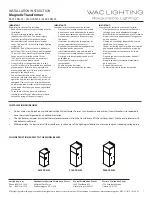
TM Page 26
shaft material young’s modulus and poisons ratio. The calculated gain required is displayed and
calibration resistor value can be calculated.
Strain Bridge
For connection to a strain bridge. The default output is µ
ε
. Settings are µ
ε
full scale, gauge factor
and number of active gauges. The calculated gain required is displayed and calibration resistor
value can be calculated.
Manual
Allows the gain to set manually. The calculated gain required is displayed and calibration resistor
value can be calculated. For a transmitter with resistor set gain (TX31D etc) the calculated gain
set resistor value is displayed.
4.3.9.2
Transducer mV/V
Used when a transducer or bridge has a known mV/V output. This allows the calibrated value to be directly entered. Note
that the position of the decimal controls how many decimal points are displayed on the front panel display.
DISPLAY, Strain Tx Setup, DISPLAY, transducer mV/V, DISPLAY, SET, Set full scale mV/V. DISPLAY
4.3.9.3
µ
ε
Full Scale
Enter the full scale µ
ε
range desired. The gain required to achieve this will be automatically calculated and this can be sent
to programmable transmitters or the required gain resistor is calculated and displayed for resistor programmable types.
Note that the position of the decimal controls how many decimal points are displayed on the front panel display.
DISPLAY, Strain Tx Setup, DISPLAY, µ
ε
Full Scale, DISPLAY, SET, Set full scale µ
ε
. DISPLAY
4.3.9.4
Calculated Gain
The Gain calculated from the entered setup vales is displayed and this can be sent to programmable transmitters by
selecting the Send Now option.
DISPLAY, Strain Tx Setup, DISPLAY, Calculated Gain, DISPLAY, SET, Select Send Now if required.
4.3.9.5
Calibration Resistor
The calibration resistor value can be calculated.
DISPLAY, Strain Tx Setup, DISPLAY, Calibration Resitor, DISPLAY, SET, ???.
4.3.9.6
Gauge Setup
For input types that require the strain gauge bridge to be setup. The gauge factor (typically 2.00) and the number of active
gauges (eg 4 for a full torque bridge) can be entered.
DISPLAY, Strain Tx Setup, DISPLAY, Gauge Setup, DISPLAY, SET, Set gauge DISPLAY
4.3.9.7
Shaft Size
This allows the shaft size to be entered for the Torque Shaft input type to enable torque in Nm to be calculated and
displayed. The outside diameter (OD) and the internal diameter (ID) for a hollow shaft are entered in mm. Enter an ID of 0
for a solid shaft.
DISPLAY, Strain Tx Setup, DISPLAY, Shaft Size, DISPLAY, SET, Set OD and ID DISPLAY
4.3.9.8
Shaft Material
This allows the Young’s Modulus and poisons ratio of the shaft material to be entered for the Torque Shaft input type to
enable torque in Nm to be calculated and displayed. The Young’s Modulus is entered in GPa, typical values are; Aluminium
= 69 GPa, titanium = 110 GPa, wrought iron 200 GPa, steel – 200GPa
Poisons ratio is the ratio of strain in the lateral direction to strain in the axial direction, when a tensile stress is applied to a
material. Its value for many solids is close to 1/3. Typical values are; aluminium and titanium 0.33, steel 0.29, magnesium
0.35
DISPLAY, Strain Tx Setup, DISPLAY, Shaft Material, DISPLAY, SET, Set Young’s Modulus and Poisons Ratio
Summary of Contents for TX31D/1/IFM
Page 2: ...TM Page 2 ...
















































